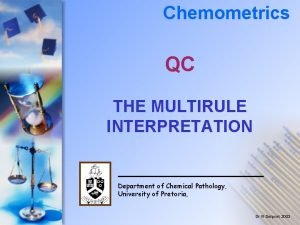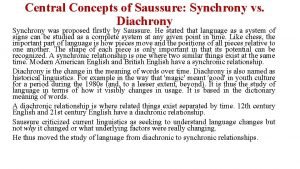Largescale synchrony within and across frequencies in restingstate

- Slides: 1

Large-scale synchrony within and across frequencies in resting-state SEEG data Felix 1 Siebenhühner , Gabriele 2 Arnulfo , Lino 3 Nobili , 1 Palva , Matias Satu 1 Palva 1: Neuroscience Center, University of Helsinki; 2: Universita degli Studi di Genova; 3: Claudio Munari Epilepsy Surgery Centre, Niguarda Hospital, Milan Phase Synchrony Strength A (1) B A B A True CFS/PS Spurious CFS/PS B A Sinusoidal a Sinusoidal b True positives Non-sinusoidal a Harmonic b False negatives Subharmonic a Non-sinusoidal b True negatives (3) . 1 K . 01 10 20 30 40 50 70 100 Non-zero-mean, amplitudemodulated b Regular b signal 20 30 40 50 70 100 20 30 50 100 3 4 56 10 20 30 50 100 . 01 . 2 K . 3 PLV . 4 . 1 . 5 0. 1 10 Frequency [Hz] 3 4 56 Frequency [Hz] 10 20 30 50 Frequency [Hz] 100 3 4 56 10 20 30 50 100 Frequency [Hz] • In 1: 2 CFS, strength and connection density followed similar patterns for all functional subsystems • In 1: 3 CFS, strength is similar across subsystems Conclusions Subsytems: Vis = Visual, SM = Somatomotor, DA = Dorsal Attention, VA = Ventral Attention, Lim = Limbic, FP = Frontoparietal, DM = Default Mode Degree 1: 3 Connection Density 1: 3 Strength . 4. 3. 2 30 40 50 70 100 Frequency [Hz] § Significant Cross-Frequency synchrony (CFS) is observed in human SEEG data in resting state § Observed CFS can not be explained by possibly spurious CFS § Strength and Connection density of both PS and CFS tend to be similar across functional subsystems § Hubs of the low-frequency PS networks and 1: 2 CFS networks are correlated Betweenness Centrality. 5 References . 4. 3 Arnulfo G, et al. (2015): ‘Phase and amplitude correlations in resting-state activity in humanstereotactical EEG recordings’, Neuro. Image, 112, pp. 114 -127 Fries P (2015): ‘Rhythms for Cognition: Communication through coherence’, Neuron, 88, pp. 220 -235 . 2 . 5 10 Frequency [Hz] 1: 2 Connection Density PLV . 1 0 20 Gerber EM, et al. (2016): ‘Non-Sinusoidal Activity Can Produce Cross-Frequency Coupling in Cortical Signal in Absence of Functional Interaction between Neural Sources’, PLo. S One, e 0167351 3 4 5 6 Palva JM, et al. (2005): ‘Phase synchrony among neuronal oscillations in the human cortex’, Journal of Neuroscience, 25/15, pp. 3962 -3972 10 20 30 50 100 3 4 5 6 10 20 30 50 100 Frequency [Hz] a signal m signal 3 4 5 6 7 0. 1 . 4. 2 . 3 K . 06 0 0 . 1 . 02 PLV . 04 . 3. 2 K K . 16. 12 3 4 5 6 7 . 1 b signal B (3) 10 • Both strength and connection density K of phase synchrony peak in a band • a peak can be observed in all functional subsystems Frequency [Hz] (2) A a signal B (2) 3 4 5 6 7 . 1 (1) 30 40 50 70 100 0 B 30 40 50 70 100 . 4 A 20 . 3 B 20 . 2 A 10 1: 2 Strength . 1 B 10 0 A 3 4 5 6 7 Frequency [Hz] Correlation between PS and CFS hubs Spurious CFS B 30 40 50 70 100 3 4 56 Pearson’s r A 20 • Significant CFS was observed at 1: 2 between q and a and between a and b bands and 1: 3 between a and b/g • Significant CFS was reduced, but still showed same patterns with very conservative controlling for spurious CFS (right) Frequency [Hz] § Theoretically, spurious CFS might arise as a result of PS and local CFS and of harmonic or subharmonic components of non-sinusoidal signals § Importantly, both sinusoidal and non-sinusoidal signals may be accompanied by true CFS. § We developed a conservative approach for detecting true CFS. We posit that spurious CFS must always be accompanied with 1: 1 PS. In our model scheme of this approach all full “triangle motifs” of PS, local CFS & long-range CFS are discarded; this rules out all spurious CFS observations and also may discard a number of true CFS connections. B 10 Frequency [Hz] . 04 0 3 4 5 6 7 Controlling for possible spurious CFS A 3 4 5 6 7 30 40 50 70 100 . 08 PLV § Stereotactical EEG (SEEG) data were recorded from epileptic patients undergoing pre-surgical clinical assessment § Data was recorded from monopolar (with shared white matter reference) local field potentials (LFPs) from brain tissue with platinum–iridium, multi-lead electrodes § Closest White Matter (CW) scheme was used for referencing [Arnulfo 2015] § 38 subjects with 116± 17 channels each, recording time 10 min § Only cortico-cortical connections between non-epileptic channels were analyzed § Data were filtered into 31 center frequencies from 3. 3 – 100 Hz using Morlet wavelets § 1: 1 phase synchrony (PS) and cross-frequency phase synchrony (CFS, for ratios 1: 2 – 1: 6) were computed with the phase-locking value (PLV) over the whole time period (time windows with spiky/epileptic activity excluded) § Surrogate values were constructed by shifting time series by a random number of samples § The connection density K was computed as the fraction of connections above 2. 42*mean(surrogates) over the total number of possible connections § Electrode locations were assigned to the functional subsystems defined by Yeo et al. [Yeo 2011] B 20 Frequency [Hz] f 2 f 1 Materials and Methods A 10 n: m-phase synchrony (here 1: 3) f 1 True CFS . 08 . 4. 16. 12. 08 3 4 5 6 7 K 1: 1 phase synchrony 0 Hypothesis: Long-range CFS connects networks of cortical oscillations in resting state Connection Density with spurious control Connection Density without spurious control Strength Connection Density . 04 PLV § Long-range within-frequency (1: 1) phase synchrony (PS) of neuronal oscillations regulates neuronal communication among human brain areas [Fries 2015]. § Large-scale PS networks are crucial for cognitive functions [Palva 2012, Siegel 2012, Petersen 2015]. § Neuronal activity during task performance is also characterized by n: m cross-frequency phase synchrony (CFS), which may coordinate processing across distinct frequencies [Palva 2005, Siebenhühner 2016]. § Yet, concerns have been raised over the possibility of CFS observations being spurious [Gerber 2016, Scheffer-Tezeira 2016] § Observations of long-range CFS in human resting-state data have been sparse [Palva 2005], and it has not been investigated whether it connects PS networks Cross-Frequency Synchrony . 1 Introduction § Hubs of PS networks, as identified by node degree and betweenness centrality, of q, a and b bands and corresponding 1: 2 and 1: 3 CFS networks are significantly correlated across subjects (Pearson correlation, p=0. 05, Benjamini-Hochberg corrected) § Significant correlations were also found in most individual subjects for both metrics Palva S, Palva JM (2012): ’Discovering oscillatory interaction networks with M/EEG: challenges and breakthroughs’, Trends in Cognitive Sciences, 16/4, pp. 219 -230 Petersen SE, Sporns O (2015): ‘Brain Networks and Cognitive Architectures’, Neuron, 88, pp. 207 -219 Scheffer-Teixerira R, Tort ABL (2016): ‘On cross-frequency phase-phase coupling between theta and gamma oscillations in the hippocampus’, e. Life 5: e 20515 Siebenhühner F, et al. (2016): ‘Cross-frequency synchronization connects networks of fast and slow oscillations during visual working memory maintenance’, e. Life 5: e 13451 Siegel M, et al. (2012): ‘Spectral fingerprints of large-scale neuronal interactions’, Nature Reviews Neuroscience, 13, pp. 121 -134 Yeo BT, et al. (2011): ‘The organization of the human cerebral cortex estimated by intrinsic functional connectivity’, Journal of Neurophysiology 106, pp. 1125– 1165. This work was supported by: Academy of Finland, Helsinki University Research Funds, Doctoral Program of Brain & Mind of the University of Helsinki.

